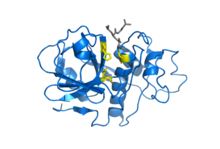- Cysteine protease
-
Cysteine Peptidase 
Crystal structure of the cysteine peptidase papain in complex with its covalent inhibtor E-64. Rendered from PDB 1PE6 Identifiers Symbol Peptidase_C1 Pfam PF00112 Pfam clan CL0125 InterPro IPR000668 SMART SM00645 PROSITE PDOC00126 MEROPS C1 SCOP 1aec Available protein structures: Pfam structures PDB RCSB PDB; PDBe PDBsum structure summary Proteases are enzymes that degrade polypeptides. Cysteine proteases have a common catalytic mechanism that involves a nucleophilic cysteine thiol in a catalytic dyad. The first step is deprotonation of a thiol in the enzyme's active site by an adjacent amino acid with a basic side chain, usually a histidine residue. The next step is nucleophilic attack by the deprotonated cysteine's anionic sulfur on the substrate carbonyl carbon. In this step, a fragment of the substrate is released with an amine terminus, the histidine residue in the protease is restored to its deprotonated form, and a thioester intermediate linking the new carboxy-terminus of the substrate to the cysteine thiol is formed. Therefore they are also sometimes referred to as thiol proteases. The thioester bond is subsequently hydrolyzed to generate a carboxylic acid moiety on the remaining substrate fragment, while regenerating the free enzyme.
Cysteine proteases are commonly encountered in fruits including papaya, pineapple, fig and kiwifruit. The proportion of protease tends to be higher when the fruit is unripe. In fact, dozens of latices of different plant families are known to contain cysteine proteases.[1] Cysteine proteases are used as an ingredient in meat tenderizers.
Contents
Biological importance
Cysteine proteases play multi-faceted roles, virtually in every aspect of physiology and development, in plants such as in the growth and development, in senescence and programmed cell death, in accumulation and mobilization of storage proteins such as in seeds. In addition, they are involved in signalling pathways and in the response to biotic and abiotic stresses.[2][3] In humans they are responsible for apoptosis, MHC class II immune responses, prohormone processing, and extracellular matrix remodeling important to bone development. The ability of macrophages and other cells to mobilize elastolytic cysteine proteases to their surfaces under specialized conditions may also lead to accelerated collagen and elastin degradation at sites of inflammation in diseases such as atherosclerosis and emphysema.[4]
In several traditional medicines the fruits or latex of papaya, pineapple and fig are widely used for treatment of intestinal worm infections both in humans and livestock animals. Plant cysteine proteinases isolated from these plants have been found to have high proteolytic activities that are known to digest nematode cuticles, with very low toxicity.[5] Successful results have been reported against nematodes such as Heligmosomoides bakeri, Trichinella spiralis, Nippostrongylus brasiliensis, Trichuris muris, and Ancylostoma ceylanicum; the tapeworm Rodentolepis microstoma and the porcine acanthocephalan parasite Macracanthorynchus hirundinaceus.[6]
Examples of cysteine proteases
- Actinidain
- Bromelain
- Calpains
- Caspases
- Cathepsins
- Mir1-CP
- Papain
Protease regulation
Proteases are usually synthesized as large precursor proteins called zymogens, such as the serine protease precursors trypsinogen and chymotrypsinogen, and the aspartic protease precursor pepsinogen. The protease is activated by removal of an inhibitory segment or protein. Activation occurs once the protease is delivered to a specific intracellular compartment (e.g. lysosome) or extracellular environment (e.g. stomach). This system prevents the cell that produces the protease from being damaged by it.
Protease inhibitors are usually proteins with domains that enter or block a protease active site to prevent substrate access. In competitive inhibition, the inhibitor binds to the active site, thus preventing enzyme-substrate interaction. In non-competitive inhibition, the inhibitor binds to an allosteric site, which alters the active site and makes it inaccessible to the substrate.
Examples of protease inhibitors
References
- ^ Domsalla A, Melzig MF. (2008). "Occurrence and properties of proteases in plant latices". Planta Med. 74 (7): 699–711. doi:10.1055/s-2008-1074530. PMID 18496785.
- ^ Grudkowska M, Zagdańska B (2004). "Multifunctional role of plant cysteine proteinases". Acta Biochim Polonica. 51 (38): 609–624. http://www.actabp.pl/pdf/3_2004/609s.pdf.
- ^ Salas C, Gomes TMR, Hernandez M, Lopes MTP (2008). "Plant cysteine proteinases: Evaluation of the pharmacological activity". Phytochemistry 69 (12): 2263–2269. doi:10.1016/j.phytochem.2008.05.016. PMID 18614189.
- ^ Chapman HA, Riese RJ, Shi GP. (1997). "Emerging roles of cysteine proteases in human biology". Ann Rev Physiol. 97: 63–88. doi:10.1146/annurev.physiol.59.1.63. http://arjournals.annualreviews.org/doi/full/10.1146/annurev.physiol.59.1.63.
- ^ Stepek G, Behnke JM, Buttle DJ, Duce IR. (2004). "Natural plant cysteine proteinases as anthelmintics?". Trends Parasitol. 20 (7): 322–327. doi:10.1016/j.pt.2004.05.003. PMID 15193563. http://www.sciencedirect.com/science?_ob=ArticleURL&_udi=B6W7G-4CF5B1C-2&_user=10&_coverDate=07%2F01%2F2004&_rdoc=1&_fmt=high&_orig=search&_sort=d&_docanchor=&view=c&_searchStrId=1284152433&_rerunOrigin=scholar.google&_acct=C000050221&_version=1&_urlVersion=0&_userid=10&md5=8e4a7d962c243d32ff61fdd08de37c46.
- ^ Behnke JM, Buttle DJ, Stepek G, Lowe A, Duce IR. (2008). "Developing novel anthelmintics from plant cysteine proteinases". Parasites & Vectors 1: 29. doi:10.1186/1756-3305-1-29. http://www.biomedcentral.com/content/pdf/1756-3305-1-29.pdf.
External links
- The MEROPS online database for peptidases and their inhibitors: Cysteine Peptidases
- MeSH Cysteine+endopeptidases
See also
- The Proteolysis Map
Hydrolase: proteases (EC 3.4) 3.4.11-19: Exopeptidase Dipeptidyl peptidase (Cathepsin C, Dipeptidyl peptidase-4) · Tripeptidyl peptidase (Tripeptidyl peptidase I, Tripeptidyl peptidase II)Other/ungrouped3.4.21-24: Endopeptidase Serine proteases · Cysteine protease · Aspartic acid protease · Metalloendopeptidases
Other/ungrouped: Amyloid precursor protein secretase (Alpha secretase, Beta-secretase 1, Beta-secretase 2, Gamma secretase)3.4.99: Unknown Caspase Caspase 1 · Caspase 2 · Caspase 3 · Caspase 4 · Caspase 5 · Caspase 6 · Caspase 7 · Caspase 8 · Caspase 9 · Caspase 10 · Caspase 12 · Caspase 13 · Caspase 14Fruit-derived Calpain Cathepsin Other Categories:- EC 3.4.22
Wikimedia Foundation. 2010.

